
Back تآصل الكربون Arabic কার্বনের অ্যালোট্রপ Bengali/Bangla Alótropos del carbono Spanish دگرشکلهای کربن Persian Allotropie du carbone French Alotrop karbon ID कार्बनची अपरूपे Marathi Alótropos do carbono Portuguese Аллотропия углерода Russian Allotropes of carbon SIMPLE

| Part of a series of articles on |
| Nanomaterials |
|---|
 |
| Carbon nanotubes |
| Fullerenes |
| Other nanoparticles |
| Nanostructured materials |
Carbon is capable of forming many allotropes (structurally different forms of the same element) due to its valency. Well-known forms of carbon include diamond and graphite. In recent decades, many more allotropes have been discovered and researched, including ball shapes such as buckminsterfullerene and sheets such as graphene. Larger-scale structures of carbon include nanotubes, nanobuds and nanoribbons. Other unusual forms of carbon exist at very high temperatures or extreme pressures. Around 500 hypothetical 3‑periodic allotropes of carbon are known at the present time, according to the Samara Carbon Allotrope Database (SACADA).[1]
- ^ Hoffmann, R.; Kabanov, A.; Golov, A.; Proserpio, D. (2016). "Homo citans and carbon allotropes: For an ethics of citation". Angewandte Chemie. 55 (37): 10962–10976. doi:10.1002/anie.201600655. PMC 5113780. PMID 27438532.
© MMXXIII Rich X Search. We shall prevail. All rights reserved. Rich X Search